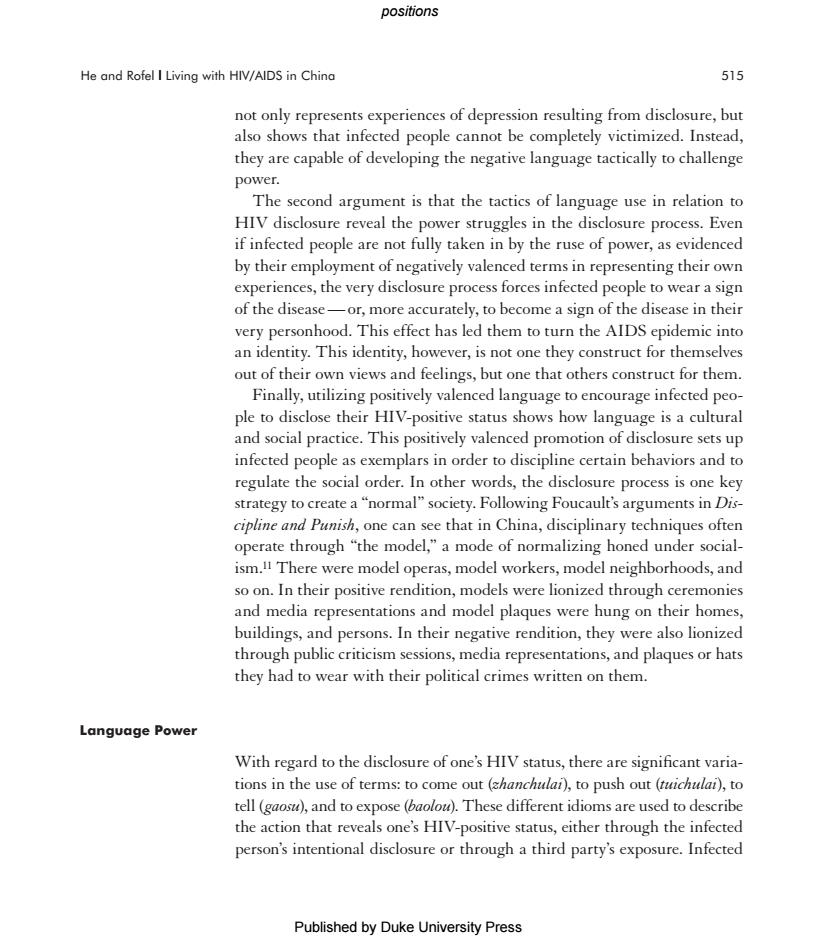正在加载图片...

positions He and Rofel I Living with HIV/AIDS in China 515 not only represents experiences of depression resulting from disclosure,but also shows that infected people cannot be completely victimized.Instead, they are capable of developing the negative language tactically to challenge power. The second argument is that the tactics of language use in relation to HIV disclosure reveal the power struggles in the disclosure process.Even if infected people are not fully taken in by the ruse of power,as evidenced by their employment of negatively valenced terms in representing their own experiences,the very disclosure process forces infected people to wear a sign of the disease-or,more accurately,to become a sign of the disease in their very personhood.This effect has led them to turn the AIDS epidemic into an identity.This identity,however,is not one they construct for themselves out of their own views and feelings,but one that others construct for them. Finally,utilizing positively valenced language to encourage infected peo- ple to disclose their HIV-positive status shows how language is a cultural and social practice.This positively valenced promotion of disclosure sets up infected people as exemplars in order to discipline certain behaviors and to regulate the social order.In other words,the disclosure process is one key strategy to create a"normal"society.Following Foucault's arguments in Dis- cipline and Punish,one can see that in China,disciplinary techniques often operate through "the model,"a mode of normalizing honed under social- ism.There were model operas,model workers,model neighborhoods,and so on.In their positive rendition,models were lionized through ceremonies and media representations and model plaques were hung on their homes, buildings,and persons.In their negative rendition,they were also lionized through public criticism sessions,media representations,and plaques or hats they had to wear with their political crimes written on them. Language Power With regard to the disclosure of one's HIV status,there are significant varia- tions in the use of terms:to come out(shanchulai),to push out (tuichulai),to tell (gaosu),and to expose(baolou).These different idioms are used to describe the action that reveals one's HIV-positive status,either through the infected person's intentional disclosure or through a third party's exposure.Infected Published by Duke University PressHe and Rofel ❘ Living with HIV/AIDS in China 515 not only represents experiences of depression resulting from disclosure, but also shows that infected people cannot be completely victimized. Instead, they are capable of developing the negative language tactically to challenge power. The second argument is that the tactics of language use in relation to HIV disclosure reveal the power struggles in the disclosure process. Even if infected people are not fully taken in by the ruse of power, as evidenced by their employment of negatively valenced terms in representing their own experiences, the very disclosure process forces infected people to wear a sign of the disease— or, more accurately, to become a sign of the disease in their very personhood. This effect has led them to turn the AIDS epidemic into an identity. This identity, however, is not one they construct for themselves out of their own views and feelings, but one that others construct for them. Finally, utilizing positively valenced language to encourage infected people to disclose their HIV-positive status shows how language is a cultural and social practice. This positively valenced promotion of disclosure sets up infected people as exemplars in order to discipline certain behaviors and to regulate the social order. In other words, the disclosure process is one key strategy to create a “normal” society. Following Foucault’s arguments in Discipline and Punish, one can see that in China, disciplinary techniques often operate through “the model,” a mode of normalizing honed under socialism.11 There were model operas, model workers, model neighborhoods, and so on. In their positive rendition, models were lionized through ceremonies and media representations and model plaques were hung on their homes, buildings, and persons. In their negative rendition, they were also lionized through public criticism sessions, media representations, and plaques or hats they had to wear with their political crimes written on them. Language Power With regard to the disclosure of one’s HIV status, there are significant variations in the use of terms: to come out (zhanchulai), to push out (tuichulai), to tell (gaosu), and to expose (baolou). These different idioms are used to describe the action that reveals one’s HIV-positive status, either through the infected person’s intentional disclosure or through a third party’s exposure. Infected positions Published by Duke University Press